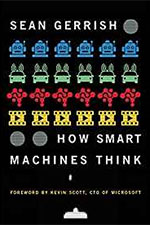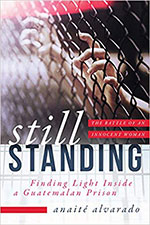 VERDICT: Touchdown!
VERDICT: Touchdown!
How Smart Machines Think
By Sean Gerrish (Cambridge, MA: The MIT Press, 2018). 298 pgs. $27.95. Order, mitpress-orders@mit.edu.
Reviewed by Douglas Bauman
The title of this book actually plays on a common misperception about the current state of the technology behind artificial intelligence (AI): that these machines are “smart” and can be said to “think.” Certainly, that is the illusion created by digital assistants such as Siri and Alexa.
But the author makes clear that modern AI is not much different from the kinds of clockwork automata that people have been building for hundreds of years. One example the author refers to repeatedly is the Flute Player, an automaton created in 1737 by Jacques de Vaucanson: a life-sized figure that could hold a real flute and play 12 pre-programmed songs. The Flute Player was powered by two rotating axles; one axle operated three sets of bellows, which provided the air to be blown through the flute, while the other turned a drum covered with studs that activated a series of levers. So, while it looked like an animated statue, the Flute Player was essentially just a big music box.
Want to Review a Book?
Please request a book and writing guidelines from Wisconsin Lawyer managing editor Karlé Lester, at klester@wisbar.org or (608) 250-6127. Reviewers may keep the book reviewed. Reviews of about 500 words are due within 45 days of receiving the book. Reviews are published, space permitting, in the order received and may be edited for length and clarity.
Likewise, while modern smart machines can appear to be thinking and performing tasks that were at one time the exclusive province of humans, they are really just more complex automata, operating according to the programs that humans have created for them. That insight was useful in helping understand the capabilities and limitations of the smart machines the author discusses.
To chart the development of AI technology, the author draws from diverse examples that might seem superficially unrelated: self-driving cars (also known as autonomous vehicles), Netflix’s movie-recommendation engine, a machine that can teach itself to play Atari games, the Jeopardy!-playing Watson, and machines that can compete with humans at chess, Go, and the video game StarCraft. But as the author explains how each machine works, he shows that many of the same techniques are used in all of them.
For the most part, the explanations are vivid and accessible, although I must confess that I sometimes had trouble following all the details. In particular, I found myself frustrated by the author’s extended metaphor about using “treats” as rewards when “training” a machine because I had wanted to understand it in a more concrete way, without the metaphor; ultimately, I had to simply accept that the machine could be programmed to seek some kind of incentive without really understanding exactly how that would be done. This is not a book that will teach you how to create your own type of AI, but it will teach you essentially how smart machines work.
Overall, the book is a fascinating look at the current state of AI. At the outset, the author proclaims that his goal was to make the book “accessible to a broad audience,” and I think he succeeded at that. I recommend the book to anyone with an interest in machine learning and AI.
Douglas Bauman, U.W. 1998, is a Marathon County Circuit Court commissioner.
 VERDICT: It’s a Keeper
VERDICT: It’s a Keeper
The Place to Meet Your Friends
By Bernard Kubale (Elabuk, 2017). 342 pgs. $14.99. Order, www.amazon.com.
Reviewed by John Becker
The author grew up in a small town, went on to become a managing partner of Foley & Lardner, and served on many boards, including those of the Brewers, the Packers, and Children’s Hospital of Wisconsin. He is currently in his 80s. If you like to hear stories from your grandfather about when he was growing up, this book is for you.
Bernard Kubale grew up in Reedsville, Wis., in the 1930s and 1940s. His mother, Josie, originally married Bill Kubale, and they had several children. After Bill died from tuberculosis, Josie married Bill’s brother, Joe Kubale (Bernard’s father). Josie’s children from her first marriage were Bernard’s half-siblings (same mother) and also his cousins (children of his father’s brother). Joe Kubale owned a bar in Reedsville, “The Place to Meet Your Friends.”
The book is basically in three parts. The first part is primarily about Bernard Kubale’s mother, who seems to have been a remarkable woman. He tells the interesting story of how she met and married Bill Kubale and discusses some of the trials and tribulations of living in a small rural town in Wisconsin. When Bill got sick with tuberculosis, his brother Joe was always there to help. He accompanied Bill to a sanitorium in Arizona, and after Bill’s death, Josie could always depend on Joe. After a few years, Joe and Josie got married and had more children.
The book then progresses to Bernard’s childhood. He tended bar while in high school, which is something most minors do not get to experience. Many of the other stories in this part are about things that many grade school and high school kids would do, although some are unique to growing up in a small town.
The last part of the book begins with the story of Bernard’s high school basketball team. It is a feel-good story about how the Reedsville basketball team overcame great odds to win the state high school basketball championship. This was when there were no divisions, and little Reedsville had to compete with teams from Racine, Madison, and Milwaukee.
The author then tells about what he went on to do after high school. This included getting a degree, joining the military, and serving in the Korean War. He finishes with a story about how he ascended Mount Rainier with his daughter when he was in his mid-60s. All this gives us background on a man who went on to a very successful law career.
The only things missing were stories about the author’s time practicing law. The book was not meant to cover his legal career, but it seems the author would have some interesting stories from after he entered the practice of law and about some of the boards on which he served. Overall, it was enjoyable and easy to read.
John A. Becker, U.W. 1982, is a principal at Becker French & Durkin, Racine.
 VERDICT: Touchdown!
VERDICT: Touchdown!
Still Standing: Finding Light Inside a Guatemalan Prison
By Anaité Alvarado (Apollo Publishers, 2018). 279 pgs. $12.91. Order, www.amazon.com.
Reviewed by Britteny LaFond
Still Standing is the author’s first-hand account of being falsely accused and placed in a Guatemalan prison. The criminal justice journey of Anaité Alvarado was heart wrenching and painfully true, for individuals facing similar circumstances in Guatemala and for those facing similar circumstances in the United States. By reading her account, I found myself comparing and contrasting the journeys my clients have here, where things are supposed to be better for prisoners.
Alvarado was thrown into the Guatemalan criminal justice system and then into prison because of her husband’s mistakes, with which she had no involvement or even knowledge. Alvarado found herself in the direst of circumstances, with her situation out of her hands, and yet she was able to positively affect the people she met along the way. Alvarado used her skills and support to help people she met inside the prison, whether it was teaching English to the other prisoners or reading books to the children of the prison (yes, you read that right, there are children of prisoners who live in the prison and are educated in classes taught by the prisoners).
Some of the best parts of the book are the stories of others; Alvarado made sure this book is not only her story but the story of everyone she met in her 65 days’ incarceration. It pains me to think about those other women. Alvarado was one of the lucky ones; she was somewhat well off financially, and family and friends visited and brought her necessities daily.
The other women weren’t so lucky. Without family, friends, or money, a prison stay in Guatemala could be deadly. The food and water the prison provides to prisoners literally is not enough to sustain life. Basic human rights appear to be ignored. Alvarado recounts far too many medical scares that occurred during her brief stay. Preparing for possible riots became Alvarado’s new normal.
Alvarado’s account properly questions the idea of justice and whether it even exists in Guatemala. Would she have ended up in prison at all if Guatemala had some of the same requirements and protections that we have here in the United States? Despite Alvarado having dual citizenship with the United States, neither the U.S. government nor the U.S. embassy intervened or came to her rescue. It was only through the love and support of her family and friends that she was able to persevere.
It was tough to put down Still Standing. While reading it, you can’t help but feel grateful that you haven’t been in the author’s position, but you also can’t shake the feeling that what happened to Alvarado was far too easy. Changes need to be made, and not just in Guatemala.
Britteny LaFond, Marquette 2015, practices solely criminal defense and criminal appeals with Petit & Dommershausen, Green Bay.
